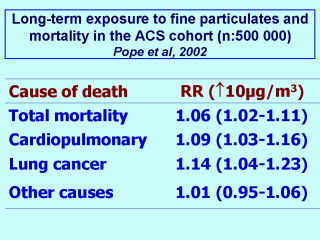 |
In another study, Pope et al
(1995a), evaluated the effects of air pollution by particles on mortality of participants
from a follow-up study of the American Cancer Society as a part of the Cancer Prevention
II study. Since 1982, data on risk factors and air pollution were collected for a total
number of 500 000 adults from 151 metropolitan areas of the United States. It was found
that the death risk by all causes in the most polluted areas was 15 per cent higher than
in those with less pollution. The risk was higher for mortality caused by cardiovascular
diseases with a 26per cent increase in the most polluted cities compared to the least
polluted ones. In March 2002 results from the follow-up of this cohort up to 1998 were
published (Pope et al., 2002). Fine particulates (PM2.5) and sulphur oxide were associated
with all-cause, lung cancer, and cardiopulmonary mortality. Each 10 µg/m3 elevation in
fine particulate air pollution was associated with approximately a 6, 9, and 14 per cent
increased risk for all cause, cardiopulmonary, and lung cancer mortality, respectively. No
association was found for other causes of mortality. |
